Poor indoor air quality affects the health of the occupants of a given structure or building. It reduces the effectiveness of learning and work efficiency. Among many pollutants, PM 2.5 and 10 dusts are extremely important. They can be eliminated using mechanical ventilation equipped with filters. Façade ventilation devices are used as a way to improve indoor air quality (IAQ) in existing buildings. For their analysis, researchers used carbon dioxide as a tracer gas. They have shown that façade ventilation devices are an effective way to improve IAQ, but require further analysis due to the sensitivity of façade ventilation devices to the effects of wind and outdoor temperature. In addition, legal regulations in some countries require verification in order to enable the use of this type of solution as a way to improve IAQ in an era characterised by the effort to transform buildings into passive houses (standard for energy efficiency in a building).
- IAQ
- façade ventilation devices
- thermal comfort
- CO2 concentration
1. Introduction
The condition of indoor air is primarily its composition. Indoor air is a mixture of dry air and water vapour. Acceptable indoor air quality, in accordance with the American Society of Heating, Refrigerating and Air-Conditioning Engineers (ASHRAE) standard [1], is defined as air in which there are no known pollutants in concentrations considered by the regulations to be harmful, and in which the vast majority of occupants (80% and more) express no dissatisfaction with thermal comfort, noise and vibrations, or with lighting.
The importance of air quality for health varies drastically depending on the level of development of a country. In developing countries, air pollution contributes to 3.7% of the disease burden, while in developed countries, the same factor is not listed among the top 10 pathogens [2][3]. According to the report of the World Health Organization (WHO) [4], 3.8 million deaths worldwide in 2016 were the result of air pollution. In low- and middle-income countries, it is responsible for 10% of all deaths, and for 0.2% of the death in low-income countries. In China alone, the number of deaths as a result of poor air condition was 111,000, and the number of emergency room visits was 4.3 million [5]. Among the threats necessitating the immediate hospitalisation of 37.9–52.2% of the population in China are: Lung diseases, cardiovascular diseases, cancer, or asthma resulting from the accumulation of toxic pollutants, harmful gases, metals, hydrocarbons, etc. [6]. The main sources of pollution are those in the outside air, coming from the industry, power plants, and motor vehicles, but also resulting from the poor quality of the fuels burned (wood, coal, kerosene, etc.) [7]. The increase in mortality is also indicated by the other authors [8], who cite gases produced by cars as the cause of a large number of deaths. How building occupants experience air quality depends on their physical condition and age [9], as well as their gender. It is women who more often than men assess the air quality as bad [10][11].
Poor air quality affects not only health [12], but also work efficiency, reducing it, and increasing the frequency of absenteeism [13][14][15][16][17][18][19][20]. In the case of schools, it lowers learning efficiency, as described in the literature [21][22]. The obvious issue is the investment costs that must be borne to improve the indoor air quality. However, the costs to the employer of the absence of the employee are about 4 to 40 times higher than the costs of installing a ventilation system. In the article [23], Sowa states that simple payback time (SBPT) for ventilation devices used to improve air quality is 1–3 years, which is really not much.
Indoor air is a mixture which is subject to dynamic qualitative and quantitative changes. According to the literature [24], in order to correctly assess the IAQ, it is first necessary to know and characterise the sources of pollutant emissions by determining the total content of pollutants (e.g., volatile organic compounds) in the material which is a potential source of emissions—then to specify the size of the pollutant emission stream from this source and to determine the chemical and physical interaction of air pollutants. When assessing the indoor microclimate, it is important to define the air exchange conditions, i.e., the amount of air and the manner in which it flows (infiltration/mechanical ventilation), as well as the condition of the air supplied from outside (potential sources of pollution in the nearest surroundings of the building). For the assessment of IAQ, the tightness of the building envelope and its permeability to pollutants are also important. Only after the IAQ has been correctly determined should a solution be sought to change its condition.
2. Improving the Indoor Air Quality
A too low exchange of air causes an increase in both the air humidity and the carbon dioxide concentration [25]. However, increasing the amount of air in naturally-ventilated facilities is not an ideal solution, as it carries the risk of lowering the internal temperature [26].
Figure 2 presents the course of changes in the relative humidity, temperature, and concentration of carbon dioxide of the indoor air from the moment students enter the classroom until they leave it. You can clearly see the improvement in air quality and the lowering of the air temperature at the same time. Students in the classroom, sitting in desks near the window, assessed the microenvironment as too cool.
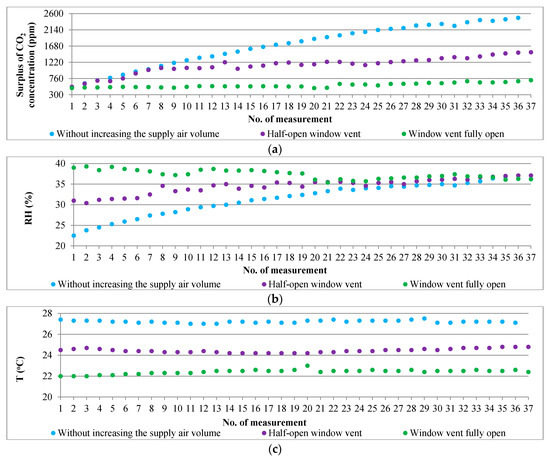
Figure 2. Changes in indoor air parameters during class [26]: (a) Surplus concentration of carbon dioxide above the external air concentration (ppm); (b) relative humidity—RH (%); (c) indoor air temperature—T (°C).
Some people use plants as a way to improve air quality to reduce pollution. Potted plants can be a means of removing chemical fumes from indoor air. The results of research and analyses [27][28] suggest that their greatest effectiveness is manifested in the removal of VOCs in energy-saving and non-ventilated facilities. Scientists document the ability of plants to remove benzene, toluene, octane, and trichlorethylene in particular [29], as well as formaldehyde [30]. However, it should be noted that plants can also be a source of pollution. Placed in plastic pots, they can be a potential source of contamination. Soil with microbes and pesticides can also pose a threat to air quality. According to an analysis conducted by scientists [31], the impact of plants on controlling air quality is actually small. The author states that the required area for green cultivation would be several square meters per person, if we were to balance the work of ventilation. In addition, plants are characterised by a high sensitivity to diseases and pests. Plants, apart from lowering the temperature, increase the humidity in the air, and moulds often appear in potting soil.
The technical equipment for the dilution of pollutants is the ventilation system. Observations presented in the literature [32] showed that the correlation between air leakage through leaks and the pressure difference is the key to understanding the interaction between the building envelope and HVAC systems (heating, ventilation, and air conditioning). Structures that are designed and built safely ensure that the pressure field is controlled, which in turn ensures that the finished buildings are healthy, durable, comfortable, and economical.
It is purposeful to reduce the energy consumption for air exchange in the premises. The solution that combines energy efficiency with an appropriate IAQ and thermal comfort is hybrid ventilation. When it is equipped with automatic regulation with soft-sensors [33], successfully this fulfils its task. In the literature [34], an analysis of indoor air quality was carried out using natural and mechanical ventilation, taking into account energy consumption. The conducted analysis showed that the presence of gaseous pollutants CO2, HCHO, O3, and NO3 does not depend on the ventilation system used. The amount of energy used to heat the air was lower with natural ventilation. In terms of the PM 2.5 dust pollution, the influence of both the type of ventilation system used and the location was observed. Moreover, the higher filtration efficiency significantly reduced the PM 2.5 concentration. The outside air pollution in months with moderate temperatures was higher than in periods of hot and cold temperatures. In the analysed climate model, there was often a need to use a hybrid air recirculation system in combination with natural ventilation in order to maintain comfortable conditions. However, in this case, the effect of filtration was never sufficient compared to mechanical ventilation. The final conclusion from the above-mentioned study is the legitimacy of using natural ventilation from the point of view of energy consumption of systems for air heating and sufficient filtration of gaseous pollutants. However, natural ventilation is insufficient with respect to PM 2.5 dust. Due to the significance of the exposure of the body to the impact of dust on health, it is extremely important to have good filtration of the incoming air, which can be obtained using mechanical ventilation. The confirmation of this thesis was obtained by means of a scientific analysis conducted in urban and rural kindergartens in the area of Silesia [35]. The authors observed an influx of atmospheric pollutants. Only those buildings featuring gas and/or coal stoves had an internal source of pollution. Due to the long stay of children in such facilities, scientists recommend implementing an air quality control strategy. On the other hand, in newly established facilities, they recommend the use of mechanical ventilation equipped with air purification systems.
Research on the harmfulness of air pollutants is of interest to many scientists. C. Arden Pope et al. [36] described the risk of respiratory diseases and cardio-pulmonary mortality due to inhalation of polluted air. In addition to describing the relationship between external pollution and diseases of people staying indoors, Badyda et al. [37][38] described the relationship between road traffic and the amount and type of harmful substances contained in indoor air, such as NO2, PM 10, or CO. They showed that in cities with heavy traffic, and thus with more gases from internal combustion engines in the outside air, the percentage of people with lung and bronchial diseases is higher.
An analysis conducted by scientists [39] showed the enormous health costs of people exposed to ozone and particulate matter. The study involved office buildings with natural ventilation to eliminate the sick building syndrome (SBS). The estimated costs of fighting the symptoms of the syndrome turned out to be lower than the costs of improving the health of people exposed to ozone and particulate matter in naturally-ventilated facilities. Scientists have noticed that the effects of the above-mentioned pollutants in naturally ventilated facilities can be reduced by closing the windows during periods when pollution levels exceed the permissible exposure limits by 10% or more. However, this would require mechanical ventilation to maintain comfort.
Scientists [40] analysed natural ventilation in office buildings as a solution to reduce energy consumption. The conclusion from their analysis is, sufficient air exchange in buildings equals 1 ÷ 6 h−1, provided that the buildings have high heat gains and these are buildings whose architecture has been designed with the awareness of the relationship between the type of building, its shape and location, with the efficiency of its natural ventilation.
The vast majority of facilities in the world are naturally–ventilated. At the same time, newly erected buildings are airtight and therefore require mechanical ventilation. Actions leading to the improvement of indoor air quality are to ensure minimisation of energy costs. This means that the air exchange in buildings cannot be too low or too high. For this reason, it is important for indoor air quality to take into account infiltration and its impact on both ventilation efficiency and energy consumption. The calculation of the infiltration efficiency largely depends on the airtightness of the building. In specific cases, the tightness of the structure is known, but in general terms, the default value should be assumed. The value that was considered reasonable is 0.3 [41][42]. Such an assumption leads to the underestimation of the ventilation efficiency for very leaky buildings, which is, however, acceptable due to erring on the safe side, i.e., the understatement of the share of infiltration in the dilution of pollutants. Similarly, for very tight objects, adopting such a value will overestimate the influence of infiltration, but here also the error is not very important, since infiltration contributes little to the total air exchange.
The distribution of pollutants in the indoor air is also influenced by the fact that movement occurs, e.g., people move about the premises or doors are opened and closed. The analysis in the hospital building was performed by Mazumdar S. et al. [43] comparing mixing and displacement ventilation. Scientists noticed variations of 10 to 90 s in the distribution of pollutants as people moved around and the pollutants following them. The average change in the concentration of pollutants resulting from the movement of the objects was within 25% for all the tested cases and was greater the closer the moving object was to the source of pollution. The authors showed that in premises with objects in motion, the use of displacement ventilation with an air exchange of 4/h will allow the same conditions to be obtained in the room as obtained with the use of a mixing ventilation system featuring an air exchange of 6/h. At the same time, the distribution of pollutant concentration using the displacement ventilation was not homogeneous. The concentration was higher near the source of the pollutants, therefore the risk of pollutant transfer in this case was greater than for the mixing ventilation.
Poor indoor air quality causes symptoms of SBS. In the literature [44], the authors analysed the influence of the ventilation system efficiency on the symptoms of the sick building syndrome. The average frequency of symptoms increased by 23% with a decrease in ventilation efficiency from 36 to 18 m3/h∙person and decreased by approximately 29% with an increase in the air stream from 36 to 90 m3/h∙person. Moreover, scientists [45][46] showed a relationship between the incidence of the sick building syndrome and gender. Regardless of the type of work performed and environmental factors, women were more likely to report ailments.
Poor indoor air quality translates into disease frequency and the efficiency of work and learning [47][48][49]. Scientists are interested in analysing the relationship between the efficiency of ventilation systems and the efficiency of learning. An example is Johnson et al. [50], whose research showed the air quality disturbances in primary schools. In many facilities, the amount of fresh air was insufficient. The dependence of work efficiency on the assessment of thermal comfort in premises and the amount of fresh air per person is shown in Figure 3 and Figure 4.
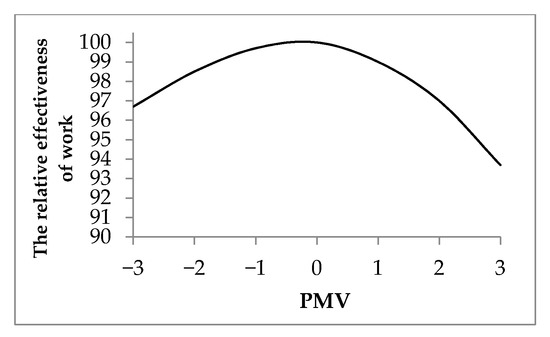
Figure 3. The relationship between thermal discomfort and the efficiency of office work (based on [51]); PMV: Predicted mean vote.
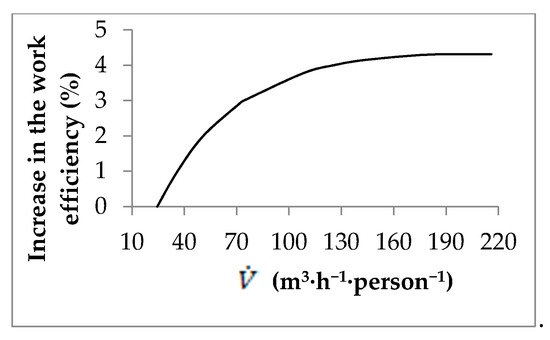
Figure 4. The dependence of the efficiency of office work on the amount of fresh air per person (based on [51]); V˙
: Fresh air stream per person)
3. Façade, Decentralised Ventilation
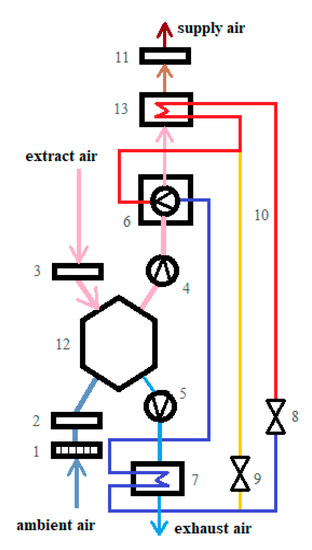
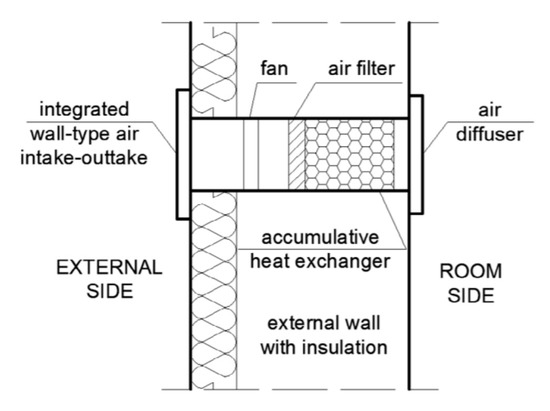
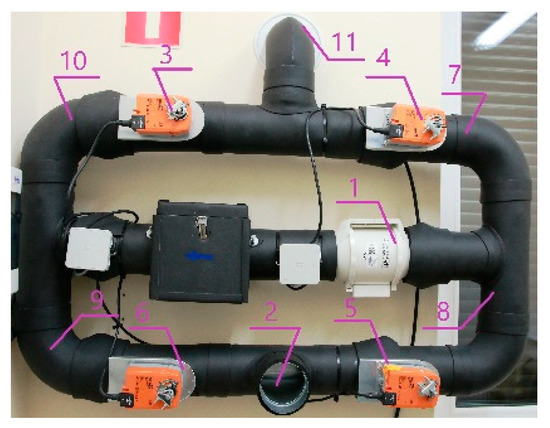
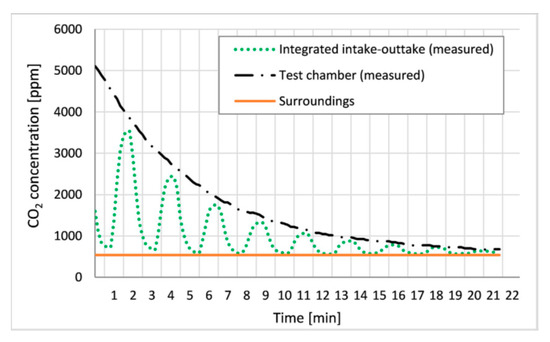
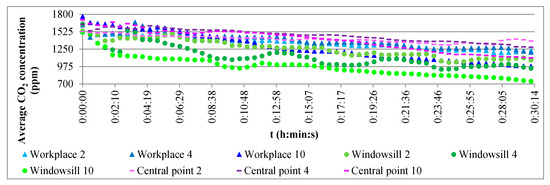
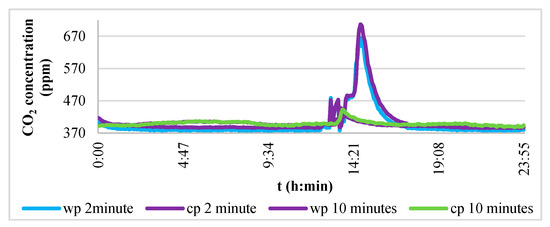
This entry is adapted from the peer-reviewed paper 10.3390/atmos12020220
References
- ASHRAE-ANSI-ASHRAE Standard 62.1-2016 Ventilation for Acceptable Indoor Air Quality; ASHRAE: Atlanta, GA, USA, 2016.
- Miśkiewicz, P. Jakość powietrza wewnętrznego—Perspektywa światowej organizacji zdrowia. In Problemy Jakości Powietrza Wewnętrznego Polsce; Wydział Instalacji Budowlanych, Hydrotechniki i Inżynierii Środowiska Politechniki Warszawskiej: Warszawa, Poland, 2005; pp. 137–140.
- Colbeck, I.; Sidra, S.; Ali, Z.; Ahmed, S.; Nasir, Z.A. Spatial and temporal variations in indoor air quality in Lahore, Pakistan. Int. J. Environ. Sci. Technol. 2018, 16, 2565–2572.
- World Health Organization. World Health Statistics (HO-WHS): Monitoring Health for the SDGS; World Health Organization: Geneva, Switzerland, 2018.
- Xie, T. Indoor air pollution and control technology. In Proceedings of the IOP Conference Series: Earth and Environmental Science, 2nd International Symposium on Resource Exploration and Environmental Science, Ordos, China, 28–29 April 2018; Volume 170, p. 032084.
- Rumana, H.S.; Sharma, R.C.; Beniwal, V.; Sharma, A.K. A retrospective approach to assess human health risks associated with growing air pollution in urbanized area of Thar Desert, western Rajasthan, India. J. Environ. Health Sci. Eng. 2014, 12, 23.
- Sharma, V.K. Importance of source apportionment modeling in air pollution abatement policy. Clean Technol. Environ. Policy 2010, 12, 3–4.
- Ilyas, S.Z.; Khattak, A.I.; Nasir, S.M.; Quarashi, T.; Durrani, R. Air pollution assessment in urban areas and its impact on human health in the city of Quetta, Pakistan. Clean Technol. Environ. Policy 2010, 12, 291–299.
- Dudzińska, M.R.; Staszowska, A.; Połednik, B. Preliminary Study of Effect of Furniture and Finishing Materials on Formaldehyde Concentration in Office Rooms. Environ. Prot. Eng. 2009, 35, 225–233.
- Topp, R.; Thefeld, W.; Wichmann, H.-E.; Heinrich, J. The effect of environmental tobacco smoke exposure on allergic sensitization and allergic rhinitis in adults. Indoor Air 2005, 15, 222–227.
- Lindgren, T.; Norbäck, D. Health and perceptron of cabin air quality among Swedish commercial airline crew. Indoor Air 2005, 15, 65–72.
- Carrer, P.; Wargocki, P.; Fanetti, A.; Bischof, W.; Fernandes, E.; De, O.; Hartmann, T.; Kephalopoulos, S.; Palkonen, S.; Sepäpnen, O. What does the scientific literature tell us about the ventilation-health relationship in public and residential buildings? Build Environ. 2015, 94, 273–286.
- Huttunen, K. Indoor Air Pollution. In Clinical Handbook of Air Pollution—Related Diseases; Capello, F., Gaddi, A.V., Eds.; Springer: Berlin, Germany, 2018; pp. 107–114.
- Daisey, J.M.; Angell, W.J.; Apte, M. Indoor air quality, ventilation and health symptoms in schools: An analysis of existing information. Indoor Air 2003, 13, 53–64.
- Mendell, M.J.; Heath, G.A. Do indoor pollutants and thermal conditions in schools influence student performance? A critical review of the literature. Indoor Air 2005, 15, 27–52.
- Seppanen, O.A.; Fisk, W.J.; Mendell, M.J. Association of ventilation rates and CO2 concentrations with health and other responses in commercial and industrial buildings. Indoor Air 1999, 9, 226–252.
- Haverinen-Shaughnessy, U.; Moschandreas, D.J.; Shaughnessy, R.J. Association between substandard classroom ventilation rates and students’ academic achievement. Indoor Air 2010, 21, 121–131.
- Tham, K.W. Effects of temperature and outdoor air supply rate on the performance of call center operators in the tropics. Indoor Air 2004, 14, 119–125.
- Apte, M.G.; Fisk, W.J.; Daisey, J.M. Associations Between Indoor CO2 Concentrations and Sick Building Syndrome Symptoms in U.S. Office Buildings: An Analysis of the 1994–1996 BASE Study Data. Indoor Air 2000, 10, 246–257.
- Apte, M.G.; Fisk, W.J.; Daisey, J.M. Indoor carbon dioxide concentrations and SBS in office workers. In Proceedings Healthy Building; Indoor Environment Department, Lawrence Berkeley National Laborator: Berkeley, CA, USA, 2000; Volume 1, pp. 133–138.
- Sowa, J. Jakość Powietrza we Wnętrzach Jako Istoty Element Pływający na Komfort Pracy, Cyrkulacje; Kielce University of Technology: Kielce, Poland, 2017; Volume 37, pp. 32–33.
- Pulimeno, M.; Piscitelli, P.; Colazzo, S.; Colao, A.; Miani, A. Indoor air quality at school and students’ performance: Recom-mendations of the UNESCO Chair on Health Education and Sustainable Development & the Italian Society of Environmen-tal Medicine (SIMA). Health Promot. Perspect. 2020, 10, 169.
- Sowa, J. Jakość Powietrza Wnętrz, a Komfort Życia i Efekty Ekonomiczne, Cyrkulacje; Kielce University of Technology: Kielce, Poland, 2016; Volume 35, p. 30.
- Zabiegała, B. Związki organiczne, ich źródła emisji i wpływ na jakość powietrza wewnętrznego. In Problemy Jakości Powietrza Wewnętrznego w Polsce; Wydział Instalacji Budowlanych, Hydrotechniki i Inżynierii Środowiska Politechniki Warszawskiej: Warszawa, Poland, 2007; pp. 233–254.
- Lazovic, I.; Stevanović, Z.M.; Jovašević-Stojanović, M.; Živković, M.M.; Banjac, M. Impact of CO2 concentration on indoor air quality and correlation with relative humidity and indoor air temperature in school buildings in Serbia. Therm. Sci. 2016, 20, 297–307.
- Telejko, M.; Zender-Świercz, E. An attempt to improve air quality in primary schools. In Proceedings of the 10th International Conference: Environmental Engineering, Vilnius, Lithuania, 27–28 April 2017.
- Wolverton, B.C. How to Grow Fresh Air: 50 House Plants that Purify Your Home Or Office; Pen-guin Books: New York, NY, USA, 1997.
- Claudio, L. Planting Healthier Indoor Air. Environ. Health Perspect. 2011, 119, a426–a427.
- Yang, D.S.; Pennisi, S.V.; Son, K.-C.; Kays, S.J. Screening Indoor Plants for Volatile Organic Pollutant Removal Efficiency. HortScience 2009, 44, 1377–1381.
- Xu, Z.; Wang, L.; Hou, H. Formaldehyde removal by potted plant–soil systems. J. Hazard. Mater. 2011, 192, 314–318.
- Sowa, J. Ocena wpływu wybranych procesów heterogenicznych na bilans dwutlenku węgla w pomieszczeniu. In Proceedings of the Problemy Jakości Powietrza Wewnętrznego w Polsce, Warszawa, Poland, 27–28 November 2005; pp. 197–208.
- Bomberg, M.; Kisilewicz, T.; Nowak, K. Is there an optimum range of airtightness for a building? J. Build. Phys. 2016, 39, 395–421.
- Vadamalraj, N.; Zingre, K.; Seshadhri, S.; Arjunan, P.; Srinivasan, S. Hybrid Ventilation System and Soft-Sensors for Maintaining Indoor Air Quality and Thermal Comfort in Buildings. Atmosphere 2019, 11, 110.
- Ben-David, T.; Waring, M.S. Impact of natural versus mechanical ventilation on simulated indoor air quality and energy consumption in offices in fourteen U.S. cities. Build. Environ. 2016, 104, 320–336.
- Błaszczyk, E.; Rogula-Kozłowska, W.; Klejnowski, K.; Kubiesa, P.; Fulara, I.; Mielżyńska-Švach, D. Indoor air quality in Urban and rural kindergartens: Short-term studies in Silesia, Poland. Air Qual. Atmos. Health 2017, 10, 1207–1220.
- Pope, C.A.; Dockery, D.W.; Schwartz, J. Review of Epidemiological Evidence of Health Effects of Particulate Air Pollution. Inhal. Toxicol. 1995, 7, 1–18.
- Badyda, A.J.; Dąbrowiecki, P.; Czechowski, P.O.; Majewski, G. Risk of bronchi obstruction among non-smokers—Review of environmental factors affecting bronchoconstriction. Respir. Physiol. Neurobiol. 2015, 209, 39–46.
- Badyda, A.J.; Dąbrowiecki, P.; Czechowski, P.O.; Majewski, G.; Doboszyńska, A. Traffic-Related Air Pollution and Respiratory Tract Efficiency. In Environment Exposure to Pollutants. Advances in Experimental Medicine and Biology; Pokorski, M., Ed.; Springer: Berlin/Heidelberg, Germany, 2015; Volume 834, pp. 31–38.
- Dutton, S.M.; Banks, D.; Brunswick, S.L.; Fisk, W.J. Health and economic implications of natural ventilation in California offices. Build. Environ. 2013, 67, 34–45.
- Nomura, M.; Hiyama, K. A review: Natural ventilation performance of office buildings in Japan. Renew. Sustain. Energy Rev. 2017, 74, 746–754.
- Sherman, M. Infiltration in ASHRAE’s Residential Ventilation Standards. In ASHRAE Transactions; Part 2, No LO-09-085; Lawrence Berkeley National Laboratory: Berkeley, CA, USA, 2009; Volume 115, pp. 887–896.
- Sherman, M.; Walker, I.S. Measured Air Distribution Effectiveness for Residential Mechanical Ventilation. HVAC&R Res. 2009, 15, 211–229.
- Mazumdar, S.; Yin, Y.; Guity, A.; Marmion, P.; Gulick, B.; Chen, Q. Impact of Moving Objects onContaminant Concentration Distributions in an Inpatient Ward with Displacement Ventilation. HVAC&R Res. 2010, 16, 545–563.
- Fisk, W.J.; Mirer, A.G.; Mendell, M.J. Quantitative relationship of sick building syndrome symptoms with ventilation rates. Indoor Air 2009, 19, 159–165.
- Muchič, S.; Butala, V. The influence of indoor environment in office building on their occupants: Expected–unexpected. Build. Environ. 2004, 39, 289–296.
- Runeson, R.; Wahlstedt, K.; Wieslander, G.; Norbäck, D. Personal and psychosocial factors and symptoms compatible with sick building syndrome in the Swedish workforce. Indoor Air 2006, 16, 445–453.
- Klavina, A.; Proskurina, J.; Rodins, V.; Martinsone, I. Carbon dioxide as indoor air quality indicator in renovated schools in Latvia. In Proceedings of the 14th International Conference of Indoor Air Quality and Climate, Ghent, Belgium, 3–8 July 2016.
- Lan, L.; Wargocki, P.; Lian, Z. Quantitative measurement of productivity loss due to thermal discomfort. Energy Build. 2011, 43, 1057–1062.
- Roelofsen, P. The impact of office environments on employee performance: The design of the workplace as strategy for productivity enhancement. J. Facil. Manag. 2002, 1, 247–264.
- Johnson, D.L.; Lynch, R.A.; Floyd, E.L.; Wang, J.; Bartels, J.N. Indoor air quality in classrooms: Environmental measures and effective ventilation rate modeling in urban elementary schools. Build. Environ. 2018, 136, 185–197.
- Wargocki, P.; Wyon, D.P. Ten questions concerning thermal and indoor air quality effects on the performance of office work and schoolwork. Build. Environ. 2017, 112, 359–366.
- Tommerup, H.; Svendsen, S. Energy savings in Danish residential building stock. Energy Build. 2006, 38, 618–626.
- Liddament, M.W.; Orme, M. Energy and ventilation. Appl. Therm. Eng. 1998, 18, 1101–1109.
- Meiss, A.; Padilla-Marcos, M.Á.; Poza-Casado, I.; Álvaro-Tordesillas, A. A Graphical Tool to Estimate the Air Change Efficiency in Rooms with Heat Recovery Systems. Sustainability 2020, 12, 1031.
- Dermentzis, G.; Ochs, F.; Siegele, D.; Feist, W. Renovation with an innovative compact heating and ventilation system integrated into the façade—An in-situ monitoring case study. Energy Build. 2018, 165, 451–463.
- Chen, Y.; Yang, H.; Luo, Y. Experimental study of plate type air cooler performances under four operating modes. Build. Environ. 2016, 104, 296–310.
- Cai, W.; Wu, Y.; Zhong, Y.; Ren, H. China building energy consumption: Situation, challenges and corresponding measures. Energy Policy 2009, 37, 2054–2059.
- Zender-Świercz, E. Microclimate in Rooms Equipped with Decentralized Façade Ventilation Device. Atmosphere 2020, 11, 800.
- Merzkirch, A.; Maas, S.; Scholzen, F.; Waldmann, D. Field tests of centralized and decentralized ventilation units in residential buildings—Specific fan power, heat recovery efficiency, shortcuts and volume flow unbalances. Energy Build. 2016, 116, 376–383.
- Kilkis, B. Exergy-Optimum Coupling of Heat Recovery Ventilation Units with Heat Pumps in Sustainable Buildings. J. Sustain. Dev. Energy, Water Environ. Syst. 2020, 8, 815–845.
- Fehrm, M.; Reiners, W.; Ungemach, M. Exhaust air heat recovery in buildings. Int. J. Refrig. 2002, 25, 439–449.
- El Fouih, Y.; Stabat, P.; Rivière, P.; Hoang, P.; Archambaukt, V. Adequacy of air-to-air heat recovery ventilation system applied in low energy buildings. Energy Build. 2012, 54, 29–39.
- Roulet, C.A.; Heidt, F.D.; Foradini, F.; Pibiri, M.C. Real heat recovery with air handling units. Energy Build. 2001, 33, 495–502.
- Mardiana-Idauy, I.A.; Riffat, S.B. An experimental study on the performance of enthalpy recovery system for building applications. Energy Build. 2011, 43, 2533–2538.
- Krechowicz, M. Risk Management in Complex Construction Projects that Apply Renewable Energy Sources: A Case Study of the Realization Phase of the Energis Educational and Research Intelligent Building. In IOP Conference Series: Materials Science and Engineering; IOP Publishing: Bristol, UK, 2017; Volume 245, p. 62007.
- Krechowicz, M. Effective Risk Management in Innovative Projects: A Case Study of the Construction of Energy-efficient, Sustainable Building of the Laboratory of Intelligent Building in Cracow. In IOP Conference Series: Materials Science and Engineering; IOP Publishing: Bristol, UK, 2017; Volume 245, p. 62006.
- Ghida, B.D. Heat Recovery Ventilation for Energy-Efficient Buildings: Design, Operation and Maintenance. Int. J. Innov. Technol. Explor. Eng. 2019, 9, 3713–3715.
- O’Connor, D.; Kaiser, J.; Calautit, S.; Hughes, B.R. A review of heat recovery technology for passive ventilation applications. Renew. Sustain. Energy Rev. 2016, 54, 1481–1493.
- Kwag, B.C.; Park, J.; Kim, S.; Kim, G.T. Evaluation of Effects of the Humidity Level-Based Auto-Controlled Centralized Exhaust Ventilation Systems on Thermal Comfort of Multi-Family Residential Buildings in South Korea. Sustainability 2019, 11, 4791.
- Franco, A.; Schito, E. Definition of Optimal Ventilation Rates for Balancing Comfort and Energy Use in Indoor Spaces Using CO2 Concentration Data. Buildings 2020, 10, 135.
- Yaïci, W.; Ghorab, M.; Entchev, E. Numerical analysis of heat and energy recovery ventilators performance based on CFD for detailed design. Appl. Therm. Eng. 2013, 51, 770–780.
- Besant, R.W.; Simonson, C.J. Air-to-air energy recovery. ASHRAE J. 2000, 42, 31–42.
- Besant, R.W.; Simonson, C. Air-to-air exchangers. ASHRAE J. 2003, 45, 42–52.
- Dieckmann, J.; Roth, K.W.; Brodrick, J. Emerging technologies: Air-to-air energy recovery heat exchangers. ASHRAE J. 2003, 45, 57–58.
- Li, B.; Wild, P.; Rowe, A. Performance of a heat recovery ventilator coupled with an air-to-air heat pump for residential suites in Canadian cities. J. Build. Eng. 2019, 21, 343–354.
- European Commission. Energy Performance of Buildings Directive 2010/31/EU(EPBD); European Parliament: Brussels, Belgium, 2010.
- European Parliament and of the Council. Commission Regulation (EU) No 1253/2014 of 7 July 2014 Implementing Directive 2009/125/EC of the European Parliament and of the Council with Regard to Eco-Design Requirements for Ventilation Units; European Parliament and of the Council: Brussels, Belgium, 2014.
- Carlsson, M.; Touchie, M.; Richman, R. Investigating the potential impact of a compartmentalization and ventilation system retrofit strategy on energy use in high-rise residential buildings. Energy Build. 2019, 199, 20–28.
- Dodoo, A. Primary energy and economic implications of ventilation heat recovery for a multi-family building in a Nordic climate. J. Build. Eng. 2020, 31, 101391.
- Koç, A.; Yağli, H.; Bilgic, H.H.; Koç, Y.; Özdemir, A. Performance analysis of a novel organic fluid filled regenerative heat exchanger used heat recovery ventilation (OHeX-HRV) system. Sustain. Energy Technol. Assess. 2020, 41, 100787.
- Manz, H.; Huber, H.; Schälin, H.; Weber, A.; Ferrazzini, M.; Studer, M. Performance of single room ventilation units with recuperative or regenerative heat recovery. Energy Build. 2000, 31, 37–47.
- Zender-Świercz, E. Improvement of indoor air quality by way of using decentralised ventilation. J. Build. Eng. 2020, 32, 101663.
- Han, H.; Kwon, Y.-I. Inhaling/Exhaling Heat Recovery Ventilator Using the Concept of Alternating-Current Ventilation. HVAC R Res. 2006, 12, 843–859.
- Merckx, M.; Bruyneel, G.; Pollet, I.; Laverge, J. Temperature, draft and ventilation efficiency of room based decentralised heat recovery ventilation systems. In Proceeding of The 39th AIVC Conference “Smart Ventilation for Buildings”, Antibes Juan-Les-Pins, France, 18–19 September 2018; pp. 838–847.
- Smith, K.M.; Svendsen, S. The effect of a rotary heat exchanger in room-based ventilation on indoor humidity in existing apartments in temperate climates. Energy Build. 2016, 116, 349–361.
- Alkan, M.A.; Keçebaş, A.; Yamankaradeniz, N. Exergo-economic analysis of a district heating system for geothermal energy. Rising specific energy cost method. Energy 2013, 60, 426–434.
- Choi, Y.; Park, B.; Park, S.; Song, D. How can we simulate the Bi-directional flow and time-variant heat exchange ventilation system? Appl. Therm. Eng. 2020, 181, 115948.
- Ratajczak, K.; Amanowicz, Ł.; Szczechowiak, E. Assessment of the air streams mixing in wall-type heat recovery units for ventilation of existing and refurbishing buildings toward low energy buildings. Energy Build. 2020, 227, 110427.
- Mikola, A.; Rehand, J.; Kurnitski, J. Air change efficiency of room ventilation units. In Proceeding of the E3S Web of Conferences; 111(01017), CLIMA 2019; EDP Sciences: Les Ulis, France, 2019.
- Rozporządzenie Ministra Infrastruktury i Budownictwa z dnia 16.09.2020r. zmieniające rozporządzenie w sprawie warunków technicznych, jakim powinny odpowiadać budynki i ich usytuowanie, Dz.U. 2020 poz. 1608. [Regulation of the Minister of Infrastructure and Construction of November 16, 2020 Amending the Regulation on the Technical Conditions to be Met by Buildings and Their Location, Dz.U. 2020 Poz.1608]. Available online: https://isap.sejm.gov.pl/isap.nsf/download.xsp/WDU20200001608/O/D20201608.pdf (accessed on 4 February 2021).
- Amanowicz, Ł.; Ratajczak, K.; Szczechowiak, E. Badania jednorurowych systemów wentylacyjnych pod kątem oceny mieszania się strumieni powietrza w czerpni i wyrzutni. Ciepłownictwo Ogrzew. Went. 2019, 1, 29–36.
- Amanowicz, Ł.; Ratajczak, K.; Szczechowiak, E. Analiza możliwości stosowania systemu wentylacji zdecentralizowanej w budynkach edukacyjnych. Instal 2019, 10, 20–26.
